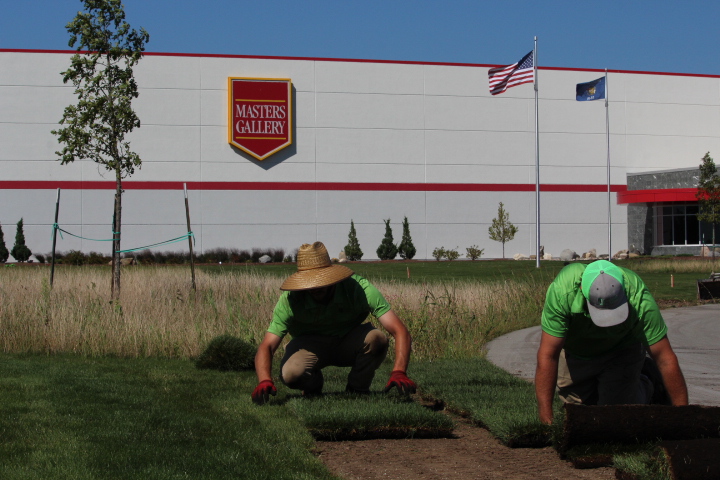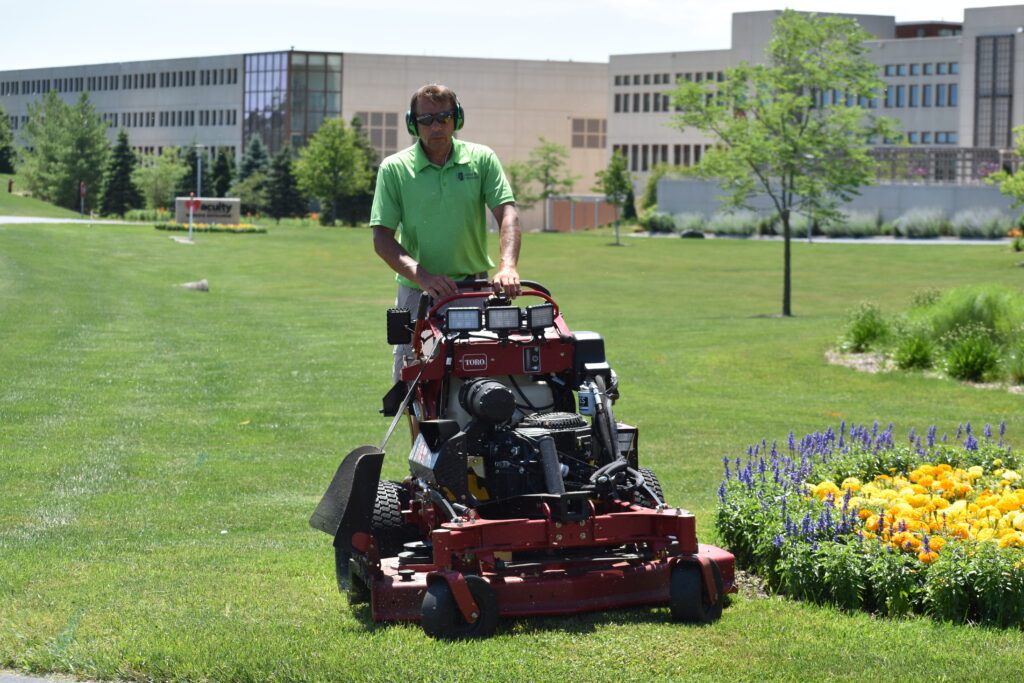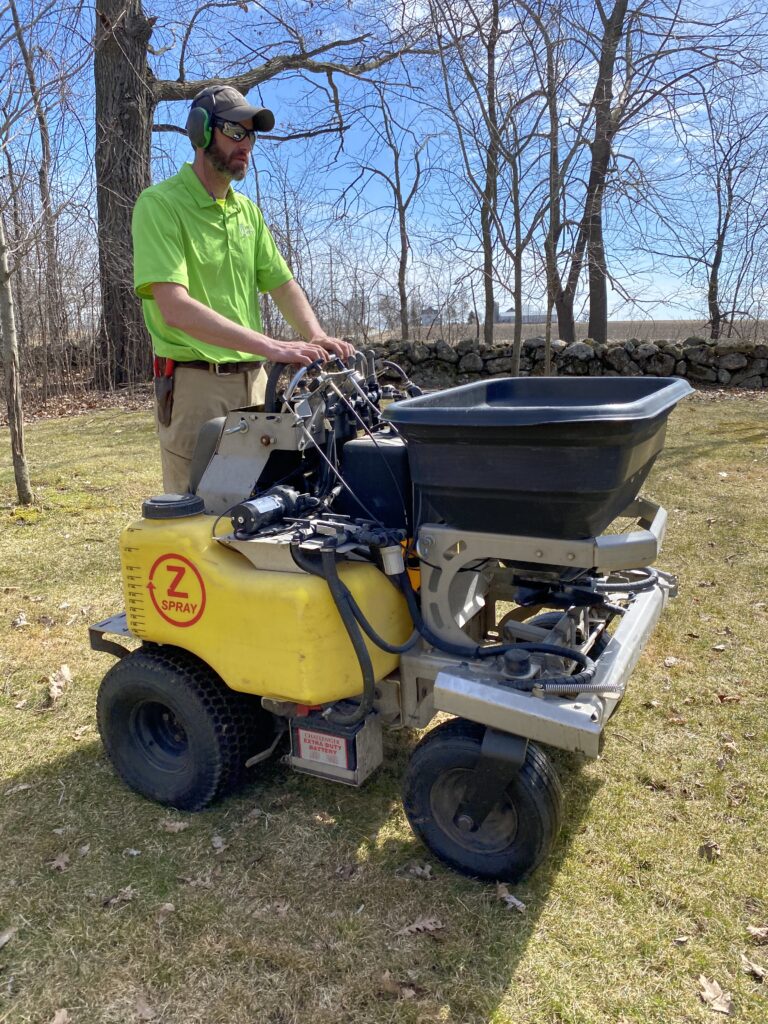
Thank you for choosing Landmark Landscapes as your turf grass specialist. Your new lawn has been installed to the highest standards and is in accordance with all industry standards and applicable state and local laws, ordinances, rules, regulations. With proper care and maintenance, your new lawn can be ready for your full enjoyment in just a few weeks. Follow the simple guidelines as explained below and you will be well on your way to owning a lawn that is sure to be the envy of the neighborhood. If you ever have any questions please contact your Account Manager or contact our office at (920) 467-6442.
Watering
It is important to give a newly sodded lawn immediate and constant attention. This means that you must keep the sod constantly moist until the first cutting. The sod has to be thoroughly wet down to the soil beneath. Light sprinkling does more harm than good. Soak the sod thoroughly, so that when any corner of the sod is lifted, it will be dripping wet. Perform this test in several places in the lawn, especially on the edges, near borders and sidewalks. These are the sod pieces that dry out first. In hot, dry weather, this will mean sprinkling each area daily, possibly several times a day if conditions are exceptionally hot, dry and windy. In cool, moist weather, sprinkling may be necessary only every second or third day.
If sod is allowed to dry out, the strips will shrink and leave gaps which will not return to their original size. The sod must make contact with the soil beneath. Water heavily for ten days, then reduce the amount of watering. Make frequent inspections to determine the moisture content of the soil. Gently lift an edge of a sod strip. If it is making good contact with the soil, you will see many strong white roots and lifting the strip will be difficult.
If possible, avoid watering late in the evening or setting automatic irrigation systems on night watering. Turf that is wet during cool or humid evenings is more prone to foliar diseases. Water during early morning so the sun will dry the blade surface and not allow fungal spores to germinate and develop.
Traffic
Although lawn establishment is faster with sod than with seeding, it is not “instant”. Care must be taken to keep traffic off the new lawn until sod starts to root as it can cause sinking in and uneven contact. Light walking across the lawn can begin after one week when the soil is not ultra-saturated, but wait a month before heavier usage.
Mowing

A newly sodded lawn will not produce much top growth at first and does not need mowing right away. Newly laid sod may not have a firm base and should not be mowed when the soil is saturated or soft. The mower height should be set to a height of at least 3 inches, Never cut more than 1/3 of the blade at a time. A lower setting could produce scalping and put the grass in a condition of shock. Riding mowers and lawn tractors should not be used when the new sod is soft. A sharp blade on your mower is always beneficial to your turf. Care should be taken not to leave a mat of grass clippings on the new sod. Mulching mowers work well or rake off mats of grass clippings to avoid smothering tender sod.
After the First Cutting
Continue to keep the soil slightly moist until the fourth cutting at which point you may treat it pretty much like any established lawn. One inch of water per week in the form of rain or sprinkling is about right. It is better to apply this 1-inch in two to three applications rather than several light sprinklings.
The object is to keep as little moisture as possible on the surface where the shallow rooted weeds like to grow. At the same time, the grass roots are forced to penetrate deeply to seek moisture.
Fertilizing

A healthy lawn is one that has a balanced proportion of top growth to roots. Roots of newly laid sod have been sheared and, therefore, re-establishment of a solid root system is very important. Do not apply a fertilizer which is high in nitrogen. High quantities of nitrogen encourage heavy top growth rather than root development. Without a well-developed root system, grass is more prone to diseases and stress during adverse weather conditions. Before placement, your sod had been grown under optimum conditions with proper fertilization and at the time of placement, the topsoil beneath was treated with fertilizer. Immediate fertilization, therefore, is not needed. After 4 to 6 weeks, apply a complete (N-P-K) fertilizer, which contains slow release nitrogen.
A simple fertilizer schedule to follow is called the “Holiday Schedule”. The first application should be made on or around Memorial Day. The second application should be made on Independence Day. The third application follows on Labor Day, the last application should be made around Halloween or after the last mowing of the season.
A yearly fertilizer program on an established lawn includes 3 to 4 pounds of actual nitrogen per 1000 square feet, which is applied in several spring and fall applications. Nitrogen (N) is the nutrient needed in the largest quantities, followed by potassium (K) and phosphorus (P). Avoid fertilizing the lawn in the heat of the summer. A slow release fertilizer will reduce danger of fertilizer burn and over stimulation of top growth.
Fall fertilizer applications are the most important. Feeding at this time helps the grass make use of this season of ideal sunlight, moisture, and temperature. This is when turf grasses are growing most actively, strengthening their roots, and tillering to develop new plants, which will fill in weak areas of the lawn. Lawns such as these are more resistant to all pests. According to University of Wisconsin research and our experience, fall feeding is essential.
Late Fall Fertilization
New shoot growth has stopped at this time of the year but the grasses’ roots are storing up food reserves. Fertilizer applied now provides the energy for grass to survive Wisconsin’s harsh winter conditions and recuperate in spring with a healthy, gradual green-up.
Weed Control – Annual Grasses
If foreign, annual grasses germinate from seed in the disturbed soil below the new sod, they are noticed as pale green, faster-growing grass in the seams between the rolls of sod. Mowing will even the appearance of the turf and these grasses only live until frost in the fall. The density of the turf will be thick enough next spring to inhibit the germination of annual grasses such as foxtail and goosegrass. If the new sod was not watered sufficiently and the sod pieces shrunk, it would be advisable to use a pre-emergent annual grass preventive treatment in the spring. Pre-emergent products do not allow annual grass seeds to germinate and should be applied in late April or early May.
Weed Control – Broadleaf Weeds
Generally, the density of the turfgrasses in new sod is so thick that broadleaf weeds cannot compete. If broadleaf weeds such as dandelions do germinate, they can be controlled by applying a granular weed and feed product or liquid spot treating of the weeds.
Disease & Insect Problems
Diseases and insect problems are hard to diagnose and advice should be sought from an expert. Do not apply chemicals haphazardly before the problem is identified.
There are two conditions that can lead to or contribute to lawn problems and diseases. One is over-fertilization. Do not add more fertilizer than the recommended rate, especially in hot, humid weather or in early spring. Over-fertilizing promotes excessive, fast, top growth and may accentuate disease development.
The second is thatch. Thatch is the matting of undecomposed dead stems, leaves and roots in a layer just above the soil surface and below the green, vegetative growth. It is not grass clippings. Too much thatch keeps water from penetrating the soil and the root zone. Roots tend to grow into the thatch rather than deeply into the soil. Insects and diseases can easily establish themselves there.
Aeration
Thatch layers 1/2 inch or more thick should be aerated to begin to break down this excessive thatch layer. Aeration by machine removes cores of thatch and soil. These plugs of soil deposited on the turf surface contain bacteria that begin to break down the thatch layer. Core aeration also opens up hardened, impenetrable soil and allows water, air and fertilizer to reach the grass roots.
All sodded lawns should be aerated annually after the first full year of growth.
Landmark Turf Services
Please consider us your partner in the long term maintenance of this landscape investment. In addition to answering any questions that may arise, we also offer comprehensive landscape maintenance and construction services. We offer full turf management services, including: mowing, trimming, aerating, fertilizing and herbicide application. Landmark Landscapes also carries all of the products you need to keep your lawn beautiful should you want to purchase them and install them yourself. If you have any questions or would like to schedule a meeting with our turf care specialist, or just a single application of herbicide or fertilizer, please call your Account Manager or contact the office: 920-467-6442.